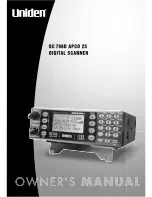
MICRO-EPSILON
X9751109-B060097MSC
25
Measurement Setup and Putting into Operation
6.5
Synchronization and Triggering
Using the "Sync in" input, the scanCONTROL measurement system can be triggered
remotely from other devices as well as within the system. If the controller has been
programmed to "external", the measurement is started with a trigger edge. The
controller then carries out a measurement with the preselected exposure time and waits
for the next trigger pulse. The interval between trigger pulses must not fall below the
reciprocal value of the profile frequency.
To synchronize a number of controllers to one another, connect the output Sync out of
Controller 1 with the correct polarity to the input Sync in of Controller 2. The
connecting cable should preferably be a shielded two-wire line, whereby the cable
screen should be connected to the plug case. As Master, Controller 1 then
synchronizes Controller 2. To do this, Controller 1 must be programmed to "internal"
and all others to "external".
Fig. 6.7: Synchronizing the scanCONTROL28x0
The output and input circuits are described in the following figures
The optocoupler at the sync input needs a current of 10 to 15 mA for operation.
Do not exceed this current value with external trigger sources.
6.6
Laser Switch-off, Mode and Encoder Inputs
The two available digital inputs with the same input circuit are configured in the
standard version as "laser on/off" and "mode" inputs. They can be directly controlled by
open collector transistor inputs or relay contacts. The power 24 V DC is
internally connected as an auxiliary power supply (see Fig. 6.10).
For all
Class 2M (IIM)
sensors the "laser on / off" input can be programmed from
"normally open" (NO, not connected) to "normal closed" (NC, connected).
For
Class 3B (IIIB)
sensors the laser is off if the connections are open.
In the optional operation mode with encoder input the function “mode” is not available.
i
IMPORTANT!
All synchronization inputs
are electrically isolated by
optocouplers. Shielded
cables must be used for the
synchronization.
Fig. 6.8: Synchronization output circuit
33 Ohm
3.3 V
Case
Sync-out
GND Sync out
laser off
on
1394
1394
1394
RS 232
video
analog
la ser on
p ower o n
er ro r
sensor
con tro l
mode
mod e 2
mod e 1
3
reset
24VD C
synchron
laser off
on
1394
1394
1394
RS 232
video
analog
la ser on
p ower o n
er ro r
sensor
con tro l
mode
mod e 2
mod e 1
3
reset
24VD C
synchron
7 1 11 6
11 6
Sync out+
11
GND
6
Sync in+
1
Sync in-
7
i
IMPORTANT!
Standard setting:
Laser Class 2M/IIM
(15
mW): the laser operates
(ON) with no connection
between the pins 13 and 3.
Laser Class 3B/IIIB
(50
mW); Laser operates (ON)
with connection between
the pins 13 and 3 only.
R
V
= -100 Ohm
U
B
- 1 V
I
E
HTL = High voltage
transistor logic
I = 10...15 mA
100 Ohm
Controller
Periphery
R
V
1
U
B
U
B
HTL
Wiring with R
V
Fig. 6.9: Synchronization input circuit
1
7
U
F
1 V
R
V
1
7
1)Resistor Rv is used in
combination with a trigger
input only.
















































